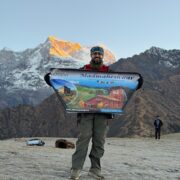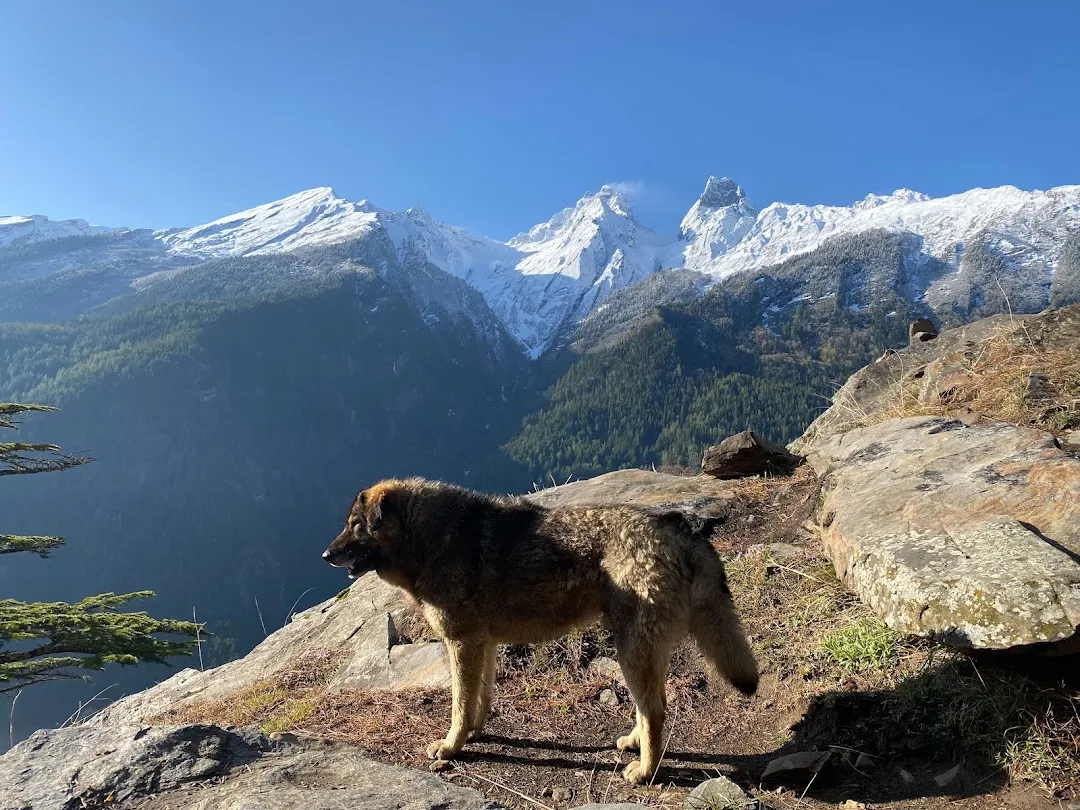
A Soulful Escape to Chopta, Tungnath & Beyond
Chopra Tungnath Trek: Tucked away in the Garhwal Himalayas of Uttarakhand, Chopta tungnath trek is a serene retreat that feels untouched by time — especially in winter, when the valley lies under a blanket of snow. This quiet hamlet is surrounded by dense forests, sweeping meadows, and snow-draped peaks, inviting you to pause, breathe deeply, and reconnect with yourself. More than just a scenic destination, Chopta is a soulful experience.
The air feels purer, the silence more profound, and the sky closer. It serves as the base for the revered Tungnath Temple, the highest Shiva temple in the world, reached by a 3.5 km trek. Trek a little further to Chandrashila, a summit offering breathtaking 360-degree views of Himalayan giants like Nanda Devi, Trishul, Chaukhamba, Kedar Dome, Bandarpoonch, and the Gangotri ranges. Nearby ranges include the Kedarnath Range and the Garhwal Himalayas. But beyond the treks and temples, Chopta offers something rarer — a deep stillness and spiritual calm that stays with you long after you leave. Whether you’re a spiritual seeker, a nature lover, or just in need of quiet, Chopta invites you — not to rush, but to simply be.
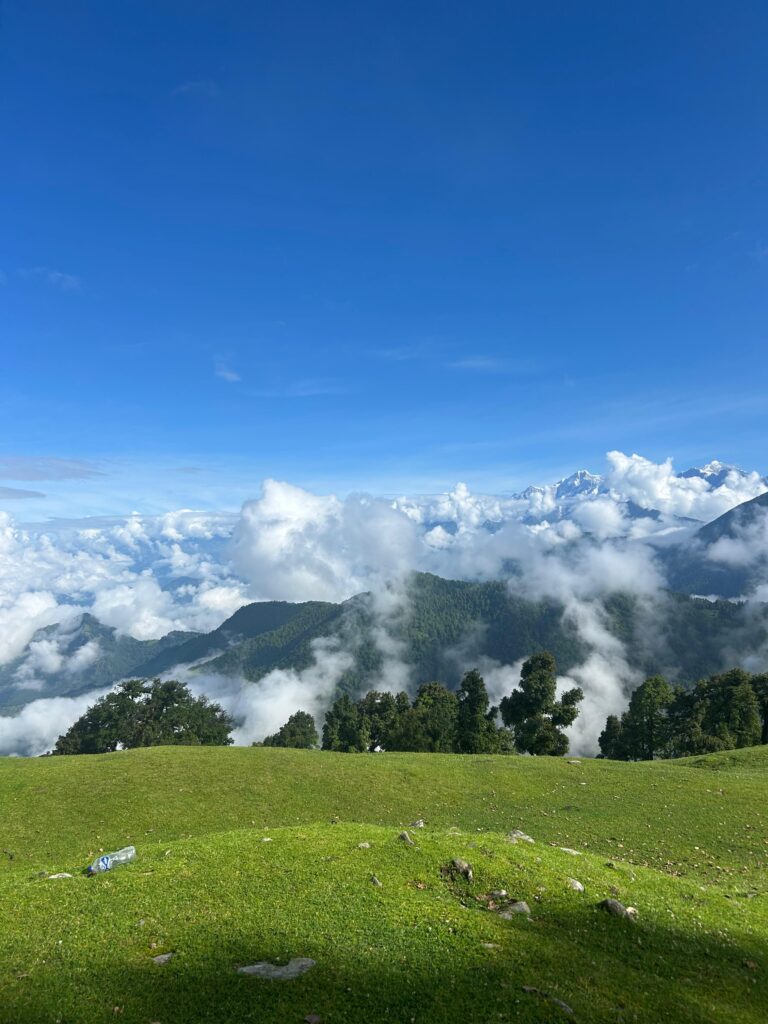
Why Visit Chopta?
Chopta, tungnath temple trek is a haven for nature lovers, spiritual seekers, and adventure enthusiasts alike. Surrounded by untouched forests and majestic Himalayan peaks, it offers a perfect blend of peace, beauty, and purpose. Whether you’re looking to trek, meditate, or simply breathe in the fresh mountain air, Chopta welcomes you with stillness and soul.
– Magical winters with snowfall
– Unspoiled natural beauty and snow-covered peaks
-Perfect for peace, solitude, and reflection
-Base for Tungnath, the highest Shiva temple
-Scenic treks to Chandrashila with 360° views
-Rich in flora, fauna, and birdlife
What truly sets Chopta apart is its ability to offer so much with so little noise. Unlike commercial hill stations, there are no loud crowds or flashy resorts — just raw nature, sacred trails, and an energy that gently heals. It’s the kind of place where sunrises leave you speechless and the silence speaks louder than words. Whether you sit quietly among the trees, hike up to a temple wrapped in mist, or simply gaze at the snow-capped peaks, Chopta gives you space — to think, to feel, and to truly be present in the moment
Best Time to Visit Chopta
Chopta, often called the “Mini Switzerland of India,” is a year-round destination — each season painting it in a different shade of beauty. Nestled in the Garhwal Himalayas at an altitude of around 2,680 meters, Chopta offers something unique in every season. Your travel experience can differ significantly based on when you visit, so here’s a detailed breakdown to help you choose the best time to explore this serene Himalayan hamlet.
Spring (March to April)
Spring in Chopta is a season of rejuvenation. As the snow begins to melt, lush green meadows start to come alive with blooming rhododendrons, clear skies, and mild temperatures. The trails to Tungnath and Chandrashila reopen after winter closure, offering breathtaking views with patches of snow still lingering along the trek. It’s an ideal time for photography, birdwatching, and comfortable trekking.
- Temperature: 10°C to 20°C
- Highlights: Fresh greenery, partially snow-covered trails, blooming flora
- Ideal for: Trekkers, nature lovers, photographers
Summer (May to June)
Summer is considered one of the best times to visit Chopta, especially for first-time travelers and trekkers. The weather is clear, days are sunny, and nights are cool — perfect for camping. The full trek route to Tungnath and Chandrashila remains open and accessible. Summer also offers excellent views of Himalayan peaks like Nanda Devi, Trishul, and Chaukhamba.
- Temperature: 12°C to 25°C
- Highlights: Clear skies, ideal trekking conditions, full trail access
- Ideal for: Trekkers, families, backpackers
Monsoon (July to September)
The monsoon brings heavy rainfall to the region, transforming Chopta into a lush green paradise. While the meadows and forests look stunningly alive, landslides and slippery trails can make travel risky. Trekking is not recommended during this time, and accommodation options may be limited.
- Temperature: 10°C to 18°C
- Highlights: Greenery at its peak, waterfalls, cloud-covered hills
- Ideal for: Offbeat travelers, nature photographers (with caution)
- Note: Travel with caution; check weather and road conditions
Autumn (October to November)
Autumn is a hidden gem season in Chopta. The skies are crisp and clear, with golden hues across the landscape. The weather is calm and stable, offering excellent visibility of the Himalayan peaks. Crowds are fewer compared to summer, making it perfect for those seeking solitude.
- Temperature: 5°C to 15°C
- Highlights: Stunning mountain views, peaceful atmosphere, post-monsoon freshness
- Ideal for: Spiritual seekers, solo travelers, photographers
Winter (December to February)
For snow lovers, winter is a magical time to visit Chopta. The entire valley is blanketed in snow, creating postcard-perfect landscapes. While the trek to Tungnath may be partially inaccessible due to snow, the views are surreal. Winter also brings a deep silence to the region, perfect for those looking to experience solitude and raw natural beauty.
- Temperature: -5°C to 10°C
- Highlights: Snow-covered meadows, peaceful ambiance, frozen trails
- Ideal for: Snow trekkers, adventure seekers, photographers
- Note: Heavy woolens, snow gear, and proper planning are essential
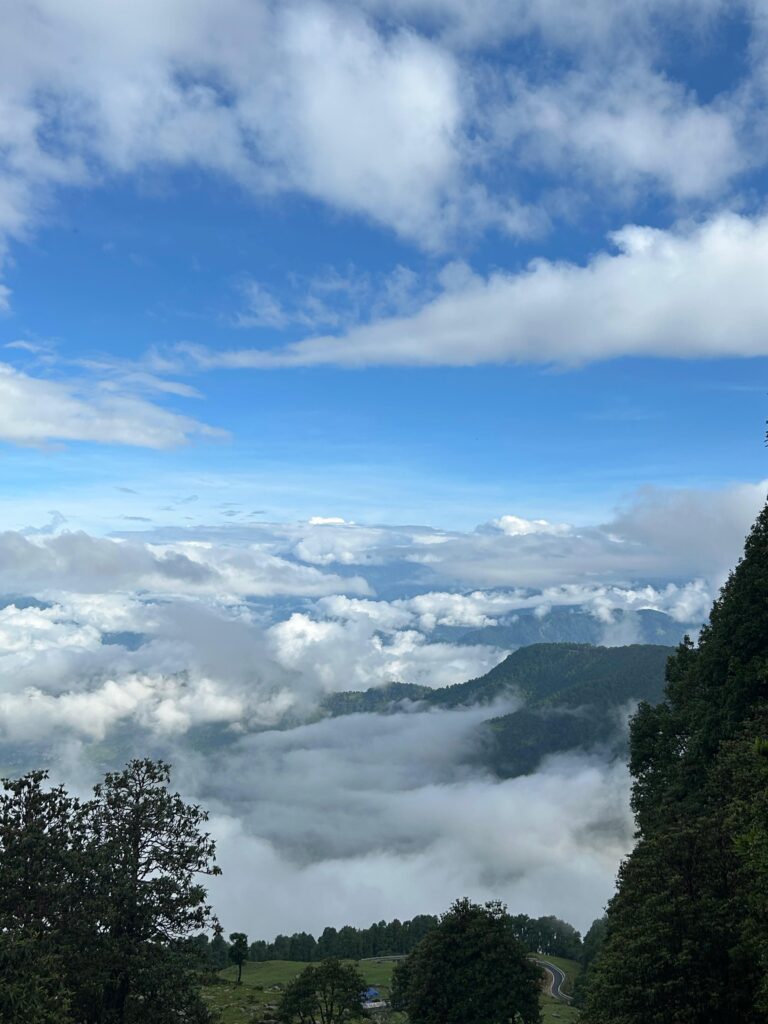
Travel Tips for Chopta
Pack your bag with
- Warm Clothing: Even in summer, evenings get chilly. Pack thermals, jackets, and gloves in winter.
- Trekking Shoes: Carry sturdy, waterproof shoes with good grip — essential for treks to Tungnath and Chandrashila.
- Rain Gear: If visiting during monsoon or shoulder seasons, pack a raincoat or poncho.
- Medicines & First Aid: Carry personal medication, basic first aid, and altitude sickness remedies.
- Power Bank & Flashlight: Electricity can be inconsistent; be prepared.
Travel & Transport
- Last Fuel Station: Fill your tank at Ukhimath or Rudraprayag, as there are no petrol pumps in Chopta.
- No ATMs Nearby: Withdraw cash beforehand — preferably in Rudraprayag or Ukhimath.
- Public Transport: Limited. Consider hiring a private cab from Rishikesh, Haridwar, or Ukhimath.
Connectivity
- Mobile Network: BSNL and Jio have the best coverage; others are unreliable.
- Internet: Expect minimal to no internet. Embrace the digital detox!
Responsible Travel
- No Plastic Zone: Avoid carrying disposable plastics. Use reusable bottles and bags.
- Respect Nature & Silence: Keep the environment clean and avoid loud music.
- Leave No Trace: Whatever you carry in, carry out. Preserve the pristine beauty.
Bonus Tips
Check weather forecasts and road conditions, especially in monsoon and winter.
Start treks early for better views and to return before dark.
Stay hydrated, especially at higher altitudes.
Stay hydrated, especially at higher altitudes.
Sightseeing in Chopta
Tungnath Temple – The Highest Shiva Shrine
Tungnath, perched at an altitude of 3,680 meters, is the highest Shiva temple in the world and one of the five Panch Kedar temples of Lord Shiva. Just a 3.5 km trek from Chopta, this sacred temple is not only a place of worship but a destination where spirituality meets adventure. The trek is moderate and suitable for beginners, winding through alpine forests, rhododendron groves, and panoramic viewpoints.
The energy here is palpable — many say the silence around Tungnath speaks louder than words. Even if you’re not religious, the serenity and sheer natural beauty of this ancient site will leave you deeply moved.
🏔️ Chandrashila Summit – Where the Himalayas Touch Your Soul
Just 1.5 km further from Tungnath lies Chandrashila, literally meaning “Moon Rock.” At an elevation of about 4,000 meters, this summit offers one of the most breathtaking 360-degree views of the Himalayan range. Peaks visible from here include Nanda Devi, Trishul, Chaukhamba, Kedarnath Dome, Bandarpoonch, and Gangotri ranges.
Chandrashila is especially magical at sunrise, when the sky gradually lights up with golden hues, casting a divine glow over the peaks. It’s more than a trek — it’s a soul-stirring experience that combines natural grandeur with spiritual fulfillment.
Devprayag Sangam – Birthplace of the Ganga
Located about 110 km from Chopta, Devprayag is one of the most sacred confluences in India, where the Alaknanda and Bhagirathi rivers meet to form the holy Ganga. This sangam holds immense spiritual significance and is a must-visit stop on your route to or from Chopta, especially if you’re traveling via Rishikesh or Rudraprayag.
The town is dotted with old temples, peaceful ghats, and traditional houses clinging to the hillsides. Watching the two differently colored rivers merge is a spiritual and visual delight — a symbol of harmony and unity.
Dhari Devi Temple – The Guardian Goddess of Uttarakhand
Situated about 70 km from Chopta near Srinagar (Uttarakhand), Dhari Devi Temple is one of the most revered shrines in the region. Set on the banks of the roaring Alaknanda River, the temple houses the upper half of the idol of Goddess Kali (the lower half is worshipped at Kalimath Temple). Locals believe that Dhari Devi protects the region and that her idol changes expressions throughout the day — calm in the morning and fierce by evening.
The temple has a mystical aura, and its location above the river gives it a serene yet powerful vibe. It’s a beautiful blend of nature, faith, and folklore.
Deoria Tal – A Mirror of the Himalayas
About 20 km from Chopta, Deoria Tal is a tranquil, high-altitude lake located at the end of a 2.3 km uphill trek from Sari Village. What makes Deoria Tal so special is its crystal-clear waters that reflect the mighty Chaukhamba peaks, creating a postcard-perfect view — especially during sunrise and sunset.
It’s an ideal spot for camping, birdwatching, stargazing, and soaking in the calm. With no vehicles allowed near the lake, it stays untouched and peaceful — perfect for those wanting to disconnect and reflect in nature’s lap.
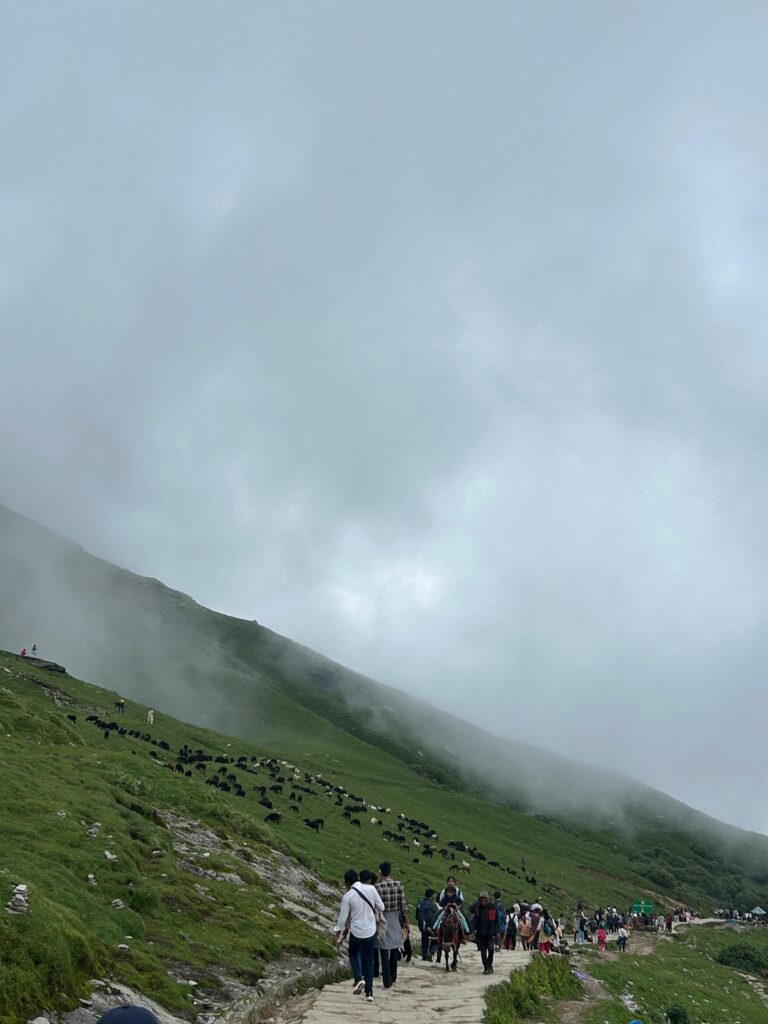
A Day in Chopta: Nature’s Rhythm Becomes Your Own
Wake up to the gentle hum of Himalayan wind weaving through deodar trees, the chirping of birds echoing across vast meadows, and the golden sun peeking over white-capped peaks. In Chopta, mornings are not rushed — they are revered. There’s no honking traffic or city stress. Just the crisp mountain air, the rustling of pine needles, and the warm aroma of chai brewing in a tin kettle over firewood.
As the mist slowly lifts, the meadows around you come alive. Locals begin their day tending to their cattle or walking barefoot into the forest to collect firewood and herbs — a rhythm in harmony with the land. Unlike destinations that urge you to “do more,” Chopta urges you to “feel more.” Here, time doesn’t fly — it flows.
Hidden Spirituality: Stories That Whisper Through Tree
Beyond the famed Tungnath and Chandrashila, the very landscape of Chopta is imbued with spiritual lore. Locals believe that the Garhwal Himalayas are not just mountains, but embodiments of gods — watching over the land with silent strength. Trees are considered sentient beings, and certain groves are avoided out of respect for their sacred presence.
You’ll often find simple rock shrines in remote corners — with fresh marigold garlands and red tika — where locals silently bow their heads. These quiet moments are a window into a deeper belief system, one that doesn’t shout religion, but lives it through reverence for nature. It’s this blend of quiet spirituality and wild landscape that makes Chopta feel more like a sacred pause than a tourist stop.
Homestays and the Warmth of Mountain Hospitality
Staying in Chopta isn’t about five-star hotels — it’s about million-star nights. Opting for a homestay here means being welcomed into the life of the mountains. You’ll be served steaming bowls of pahadi dal, locally grown rice, and rotis made on a wood-fired chulha. Meals are not rushed; they are rituals — served with stories of the land, weather, gods, and ghosts of the forest.
In many homestays, electricity is a luxury, and internet barely exists — yet you never feel disconnected. A smile, a shared laugh over a mispronounced Garhwali word, or a guide sharing his story about spotting a Himalayan Monal — it all weaves a fabric of human connection deeper than Wi-Fi ever could.
The Wildlife of Chopta: Where Silence Roar
Chopta’s rich biodiversity is a hidden treasure. The forests here are part of the Kedarnath Wildlife Sanctuary and are home to musk deer, Himalayan tahr, red foxes, and sometimes even leopards — although sightings are rare. Bird watchers especially cherish Chopta, as it’s one of the few places where you can easily spot the state bird of Uttarakhand — the vibrant Himalayan Monal.
In the early morning hours, if you venture into the dense forest with a local guide, you may find trails dotted with animal footprints and hear the distant call of barking deer. The silence of the forest is deep and primal — it heightens your senses and grounds your thoughts.
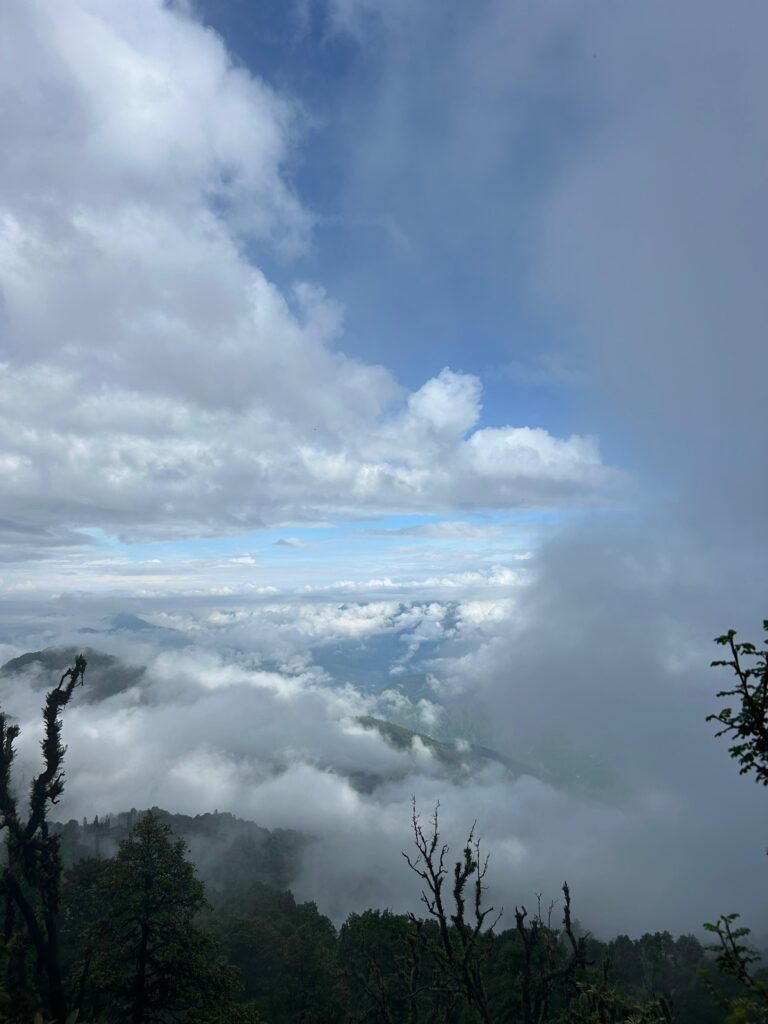
Trekking Beyond Tungnath: Exploring Offbeat Trails
While the Tungnath and Chandrashila trails are popular, there are many lesser-known paths around Chopta that offer solitude and raw Himalayan beauty:
- Baniyakund Meadows Trek: A gentle hike through undisturbed alpine fields, ideal for photographers and campers. You might spot herds of sheep grazing under golden sunlight.
- Kanakchauri to Kartik Swami Temple: Located a few hours from Chopta, this trek leads to a dramatic cliffside temple dedicated to Kartikeya. The views from here are ethereal, especially at dusk.
- Ukhimath to Sari Village Walk: A cultural trek through remote villages, giving you insight into the lives of the Garhwali people.
These trails offer a deeper connection with the land, away from crowds and with the quiet accompaniment of wind and birdsong.
Local Life and Culture: Stories Etched in Simplicity
Most residents of Chopta and surrounding villages like Duggalbitta, Baniyakund, and Sari live simple, self-sustained lives. Their days revolve around agriculture, livestock, and seasonal tourism. The harsh winters teach resilience, and the fertile summers bring celebrations.
If you get a chance to witness a local festival like Bikhauti Mela or Bagwal, you’ll be welcomed into a world of colorful rituals, folk music, and dance. Traditional instruments like the dhol damau still echo through the valleys during festivities, keeping centuries-old traditions alive.
Garhwali and Kumaoni cultures emphasize respect for nature, community bonding, and a deep-rooted spirituality — values that travel deeper than souvenirs.
Camping Under the Stars: Where Heaven Feels Closer
Camping in Chopta, especially in meadows near Baniyakund or on the way to Deoria Tal, is an experience that stays etched in memory. As night falls, temperatures dip, and a deep hush blankets the land. Then, one by one, stars start to appear — not the scattered twinkles seen in cities, but a sky bursting with celestial brilliance.
With no artificial light for miles, the Milky Way becomes visible. Some nights, the moonlight bathes the landscape in silver, casting long shadows of trees. Sitting by a crackling bonfire, wrapped in woolens, sipping hot soup, and looking up — it feels like you’re in a world untouched by time.
Healing in Nature: A Place for Soul-Seekers
Many travelers report a strange calmness in Chopta — a feeling of being held by the mountains. It’s not just the clean air or quiet; it’s the energy of the place. Even a short walk here can clear your mind. Whether it’s the silence of Tungnath Temple, the sunrise at Chandrashila, or the still reflection in Deoria Tal, something about Chopta gently nudges you inward.
It’s not uncommon to see visitors sitting quietly under a tree for hours, or journaling by the lake. For solo travelers, it becomes a sacred space of introspection. For couples, it brings emotional clarity. And for everyone, it brings healing.
If you want to visit chopta in monsoon then read our detailed blog about chopta in monsoon guide.
Chopta in Poetry & Legend
Garhwali folklore speaks of the Tungnath temple being built by the Pandavas to seek forgiveness after the Kurukshetra war. The air around the temple is said to carry the echoes of their prayers. Locals say that when the wind is strong, you can hear the gods whispering through the pine trees.
Poets and mystics have long been drawn to the Himalayas for their raw, overwhelming beauty. Chopta is part of that poetic belt — a landscape that feels like a verse waiting to be written. Every view here, from the cloud-laced peaks to the sunlit meadows, feels like nature’s stanza — timeless, sacred, profound.
Nearby Villages Worth Exploring
If you have more days in hand, consider exploring:
- Ukhimath: Known as the winter seat of Lord Kedarnath, where the deity is worshipped when Kedarnath Temple is snowed in.
- Sari Village: The gateway to Deoria Tal, full of old stone houses and friendly locals.
- Makku Math: An offbeat alternative to Tungnath — a remote temple with ancient vibes.
Each of these villages offers a unique cultural and natural lens to experience the Garhwal Himalayas beyond just sightseeing.
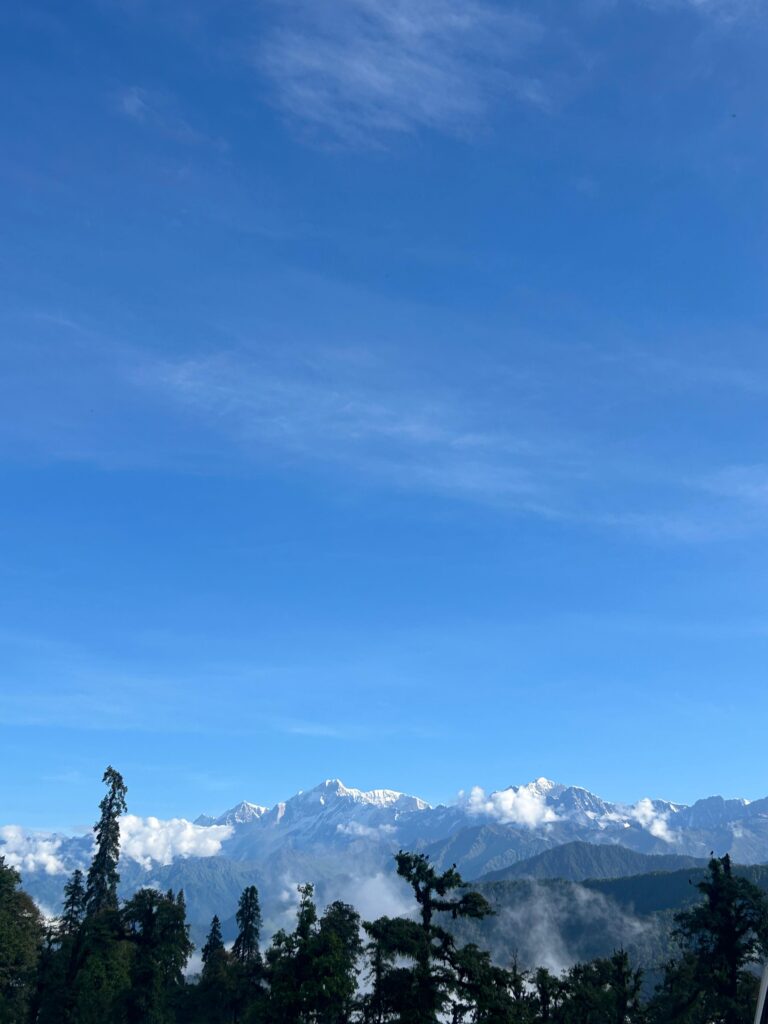
FAQs About Chopta
What else can I explore near Chopta?
Deoria Tal, Ukhimath, Dhari Devi Temple, Devprayag Sangam, and Kalimath are some beautiful and spiritual places nearby.
Where is Chopta located?
Chopta is located in the Rudraprayag district of Uttarakhand, in the Garhwal Himalayan region.
What is Chopta famous for?
It is known as the base for the Tungnath Temple trek (highest Shiva temple in the world) and for the scenic Chandrashila summit. It’s also called the “Mini Switzerland of India.”
How to reach Chopta?
You can reach Chopta via road from Rishikesh/Haridwar. The nearest railway station is Haridwar (around 200 km), and the nearest airport is Jolly Grant Airport, Dehradun.
What is the best time to visit Chopta?
March to May for clear skies and blooming rhododendrons, and December to February for snow lovers. Monsoon (July-Aug) is risky due to landslides.
How difficult is the Tungnath-Chandrashila trek?
It’s a moderate trek of around 3.5 km to Tungnath and another 1.5 km to Chandrashila. Suitable for beginners with basic fitness.
Is there snowfall in Chopta?
Yes, Chopta receives snowfall between late December and February. The area often turns into a white wonderland during this time.
Is Chopta open during winter?
Yes, but roads may get blocked due to snow. Accommodation may be limited, so it’s best to check weather and road conditions beforehand.
What are the accommodation options in Chopta?
Camps, guesthouses, and homestays are common. Duggalbitta, Baniyakund, and Sari village offer good stay options if Chopta is fully booked.
Can I do the trek solo?
Yes, but it’s better to trek with a group or guide, especially in winter when trails can be slippery and less crowded.
Is mobile network available in Chopta?
Network connectivity is limited. BSNL and Jio work in patches; Airtel and Vi are mostly unreliable.
Is Chopta suitable for family trips?
Absolutely. It’s ideal for nature walks, short treks, and peaceful retreats. Elderly members may skip the Chandrashila summit if it’s too demanding.
What should I pack for Chopta?
Warm clothes (even in summer), trekking shoes, torchlight, basic medicines, water bottles, snacks, power bank, and rain protection.
Are there ATMs in Chopta?
No. Carry sufficient cash. The nearest ATMs are in Ukhimath or Rudraprayag.
Is it safe to visit Chopta?
Yes, it’s quite safe for solo travelers, families, and couples. Just follow basic mountain safety rules.
Recent Posts
Chakrata in Winters
Madmaheshwar Trek Difficulty & Beginner’s Complete Guide
Chopta in Winters
Tags

Thailand



